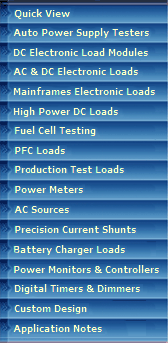

Application Notes-301
The difference between CC and CR mode
The constant current and constant resistance modes are used in conjunction for testing switching power supplies.
Caution must be exercised when using the CC mode in test set up, for example: A 5V/50A output power supply can not deliver 50A over its start up range 0-5 volts. In many cases the power supply short circuit or over current protection circuit will shut the power supply down. What is occurring is that the power supply is trying to deliver 50A at 2V because the load tester is in the CC mode. The power supply is designed not to do this.
As a result, when testing a power supply, the CR mode should be used to allow the power supply voltage and current to ramp up together. After this has occurred the CC mode should be used to complete testing. Prodigit has eliminated the need for manually switching from the CR to the CC mode with their 3310 and 3320 series Electronic Loads. They can be programmed with proper current and slew rate in the CC mode which allows a power supply to reach its specified output condition in the CC load mode.
The figure (a) is the AC line voltage to the switching power supply, (b) is the power supply's output voltage. Output voltage starts to come up at t0, and reaches its final stable voltage at t1. Figure (c) shows the load current of the unit under test when an Electronic Load is in the CR mode; (d) shows the same load current when a Load is in the CC mode. Note that the unit under test has to deliver more power from t0 to t1 in the CC mode. Figure (e) is load current using Prodigit's 3310 and 3320 series Electronic Loads.
